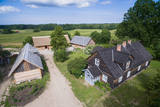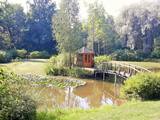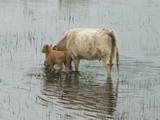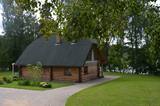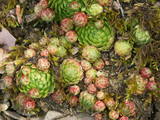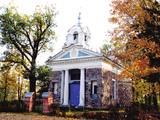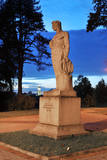| Nr | Name | Beschreibung |
|---|---|---|
|
Mūsdienās redzamais iespaidīgais dievnams tapis ilgākā laika posmā. Jau 1870. g. latviešu draudze sāka vākt ziedojumus neogotiskās baznīcas celtniecībai, ko pabeidza 1904. gadā (V. Neimaņa projekts). Ēkas iekšpusi rotā dekoratīvi zvaigžņu velvju griesti, bet tās altārdaļā izvietotasmākslinieka J. Šķērstena veidotās vitrāžas (1940. g.) un 17. gs. kristāmtrauks. Baznīcu ieskauj plašs dārzs. |
||
|
Das Museum befindet sich auf einem Hof, der der Region Ziemeļkurzeme (Nordkurland) charakteristisch ist und wo der lettische Schriftsteller Ernests Birznieks Upītis (1871 – 1960) geboren wurde. Samstags wird hier das Programm Samstag auf einem Hof angeboten, das die Möglichkeit gibt, an alltäglichen Arbeiten auf dem Land teilzunehmen und das Leben auf dem Land zu erkunden. Die Interessenten können hier die Traditionen des Brotbackens aus dem Ende des 19. Jhs. kennenlernen oder an traditionellen lettischen Festen teilnehmen. |
||
|
Dieser Biergarten befindet sich gegenüber der Brauerei Brenguļi, wo das Bier (ungefiltertes, nicht pasteurisiertes) nach dem Wissen der Vorfahren aus den Getreidekörnern gebraut wird, die von den lokalen Bauern gezüchtet worden sind. Im Biergarten kann man das helle und das dunkle Bier von Brenguļi kaufen, sowie lettische Speisen genießen. Lettische Küche: Graue Erbsen mit Speck, Würste mit Kraut, Eis von Rujiena. |
||
|
Mūsdienās redzamo (pēc skaita – trešo) baznīcu cēla laikā no 1835. - 1837. g. (ampīra stilā) Mārča Sāruma vadībā. Arī šīs ēkas projektēšanā par paraugu bija ņemts Pievolgas vācu baznīcu veidols, tādēļ tā līdzīga Dzērbenes luterāņu baznīcai. Dievnama altāri rotā Otto Donnera fon Rihtera glezna “Kristus debesbraukšana” (1898. g.). E. Martina firmā būvētās 10 reģistru ērģeles (1901. g.) darbojās arī šodien. Pie Drustu baznīcas atrodas 1932. g. atklātais un formās iespaidīgais (E. Kuraua firmas veidots) granīta piemineklis 1. pasaules karā un Latvijas Brīvības cīņās kritušo piemiņai. Nelielā baznīcas sienas nišā novietota piemiņas plāksne komunisma terora upuriem. |
||
|
Ein auf dem südostlichen Teil des Dombergs 1808 – 1810 gebautes Gebäude nennt man Wissenschaftsperle. Im Observatorium ist ein attraktives Museum eingerichtet. |
||
|
Atrodas Rīgas – Daugavpils autoceļa (A 6) 118. kilometrā. |
||
|
Einer der ältesten botanischen Parks in Litauen. 1928 begann I. Navidanskas, der zu dem Zeitpunkt erst 16 war, mit der Gestaltung des Parks. 1965 wurde der Park als Niederlitauischer Botanischer Park benannt. Izidorius Navidanskas entwickelte den Park zusammen mit seinem Sohn Rapolas Navidanskas, der gegenwärtig Besitzer des Parks ist, weiter. |
||
|
Der flache und fast zugewachsene See Engure (65% seiner Oberfläche) ist einer jener lettischen Seen, die vor allem von Vögeln bevorzugt werden. Es ist eines der Terrains, die von der Ramsar-Konvention über Feuchtgebiete verwaltet werden. 186 Arten von Nistvögeln wurden hier ermittelt. Das Gebiet zeichnet sich auch durch eine große botanische Vielfalt aus (mehr als 800 Pflanzenarten). An der Küstenlinie wechseln Sandstrände mit Küstenwiesen ab. Es gibt Wälder, Fischerdörfer, Feuchtgebiete, die die große Vielfalt der Landschaften und Arten sichern. Die Auen des Sees und des Meeres sind Weideland für Wildtiere - Pferde, blaue Kühe usw. MehrereVogelbeobachtungstürme stehen Besuchern zur Verfügung, ebenso der Orchideenpfad.
Die Ornithologische Forschungsstelle liegt am Ostufer des Engure-Sees. Eine einzigartige schwimmende Station - von Ornithologen gebaut - befindet sich auf dem See. Die Landschaft ist nicht nur für Urlauber, sondern auch für Wanderer, Radfahrer und Vogelbeobachter geeignet. Ein Erholungsplatz und eine kleine Ausstellung befinden sich neben der Ornithologischen Forschungsstelle. |
||
|
The holiday houses are located near Lake Ieva, 30 m from the lake shore. On the 1st floor of the holiday house - lounge with fireplace and glazed veranda, sauna (50.00 EUR / evening), small kitchenette, toilet. Outside-small terrace overlooking the lake. On the 2nd floor there are 2 isolated rooms and 10 beds. By the lake - a fireplace, a well-groomed swimming area with a footbridge. Boats and catamarans can be rented. |
||
|
Das ist eine kurze Strecke im Daugava – Flusstal zwischen Lielvārde und Dzelme mit Inseln und Untiefen im Fluss, sowie mit Schilf und Feuchtwiesen längsseits. Während des Vogelzuges rasten und fressen hier viele Gänse- und Regenpfeifervogelarten. Das Gebiet ist auch ein wichtiger Nistplatz für viele andere Vogelarten.
|
||
|
The workshop is in a farm, and the weaver produces blankets, carpeting, floor pathways, tablecloths, pillows, woven baskets, trays and souvenirs, as well as folk costumes on commission. She will be happy to show you her weaving and wicker-work skills. |
||
|
The shadowy cellar of the estate is a great place to hear about how homemade wine is made. You can taste rhubarb, black currant and strawberry wine along with local goodies such as cheese. Local farmers provide the ingredients for the wine. |
||
|
Auffällig sind die beiden 60m hohen Türme des im Barockstil erbauten Gotteshaus. Die Kanzel, der Orgelprospekt, die Orgel und ein Beichtstuhl stammen aus dem 18. Jh., die Seitenaltäre vom Beginn des 19. Jh. Im zentralen Teil des Altars befindet sich das Gemälde „Die wundertätige Gottesmutter von Aglona aus dem 17.Jh., dem Heilkräfte zugesagt werden, daher wird es nur zu bedeutenden Zeiten gezeigt. Vor dem Besuch des römischen Papstes Johannes Paul II in Lettland im Jahre 1993 fanden umfangreiche Renovierungs- und Umbauarbeiten am Kirchenkomplex statt. Alljährlich kommen am 15. August Pilger nach Aglona, um das Fest Mariä Himmelfahrt zu feiern. Etwa 100m von der Basilika befindet sich die heilige Quelle Aglonas Svētavots. |
||
|
Auf dieser Fahrradroute begegnen Sie mittelalterliche Burgen, geschichtsträchtige Herrenhäuser und Schlösser. Einige dieser Herrenhäuser und Schlösser sind heute Hotels. Das Gutshaus Ungurmuiža ist ein hervorragendes Beispiel für die barocke Holzbauweise im 18.Jh. In mittelalterlichen Cēsis befindet sich die Ordensburg, einst Sitz der Hochmeister des Livländischen Schwertritterordens. Weiter geht es durch den Gauja Nationalpark mit seinen einzigartigen Sandsteinklippen. Übernachtet wird in Schlössern und Gutshöfen auf dem Lande und in 4-Sterne Hotel in den Städten. |
||
|
Kulnevskaya (Ilzeskalns) Orthodox Church was built in 1832 by Kulnevs, the landlord of Ilzenberg
(Ilzeskalns) manor house. He was also the brother of Jacob Kulnevs. The Church has an iconostasis with
icons of the 19th century. The rectangular building has semicircular niches at its sides. The members of Kulnevs
family are buried here. The place of tomb is a rare phenomenon in Orthodox churches of Latvia.
|
||
|
Diese Tour bietet Ihnen die Möglichkeit, das Beste vom Winter in Lettland zu erleben. Sie beginnt in der regen Hauptstadt Riga mit ihrem Weihnachtsmarkt, Verzierungen, Einkaufsmöglichkeiten, vielen Kulturveranstaltungen und Museen, sowie mit der zauberhaften Altstadt. Danach führt die Tour auf dem Land, wo man auf Skipisten und an Schlittenhängen die Winterfreuden genießen kann. Nach einem aktiven Tag ist die Zeit gekommen, sich in einem Spa Hotel verwöhnen zu lassen, wo man auch die gesunden und einzigartigen Rituale der lettischen Sauna ausprobieren kann. Besuchen Sie die Ruinen der mittelalterlichen Burg von Sigulda, die Burg Turaida und probieren Sie den hausgemachten Wein im Landgut von Krimulda. Auf den Naturpfaden des Naturparks Ligatne können Sie sehr leicht die einheimischen wilden Tiere, z.B. Wölfe, Bären, Elche und andere beobachten. Danach können Sie auf einem unweit gelegenen Hof eine Fahrt mit einem Pferdeschlitten genießen. |
||
|
Ein 3,5 km langer Pfad quert den Viru Moos in Richtung Süd–Nord. Von einem Holzaussichtsturm eröffnet sich einen Blick auf eine typische Hochmoorlandschaft mit einigen Seen, Aushöhlungen und morastigen Stellen. |
||
|
Hiiu Gourmet ir mazs uzņēmums, kura mērķis ir piedāvāt produktus no vietējām izejvielām Hījumā. Izstrādājumi tiek izgatavoti ar rokām mazos daudzumos. Produktu klāstā ir mājās gatavoti sīrupi, piedevas, sinepes utt. No augiem un ogām, kas novāktas Hījumā mežos. Saimniece Heli padāvā Hījumā tradicionālā ēdiena gatavošanas meistarklases. |
||
|
Ein Denkmal für den Landwirtschaftsminister der Lettischen Republik Arturs Alberings. Ein vom Bildhauer Kārļis Zemdega errichtetes Denkmal wurde 1939 aufgestellt. Dieses Denkmal stellt einen Jungen mit einem Handkorb fürs Getreide dar. In der Sowjetzeit verschwand das Denkmal und an dieser Stelle wurde einen Pionier aus Gips aufgestellt. 1977 haben die Kinder die vergrabenen Teile des Denkmals gefunden, aber 10 Jahre später – den Kopf des Denkmals im Fluss Rūja. Zurzeit ist das erneuerte Denkmal an seinem ursprünglichen Ort zu sehen – im Ternejas Park nahe der Rīgas Straße. |
||
|
0,2 km nordöstlich von dem Volkshaus der Liven kann man das Haus Seppes sehen. Die Kornkammer der Wirtschaft hat Hausecken mit Rundholzverbindungen und sie wurde von dem in den 1920er – 1930er Jahren aus der Ösel gekommenen Esten – dem Fischer und Zimmermann Jēkabs Jaga gebaut. Auf der anderen Seite des Weges kann man das Haus Kalši sehen, das ein am Anfang des 20. Jhs. gebautes Wohnhaus ist. Dieses Haus ist erneuert worden, und dabei wurden in den Hauswänden die Ziegelsteine erhalten, die in der Ziegelbrennerei von Brauskas in Mazirbe gebrannt wurden. |
||

